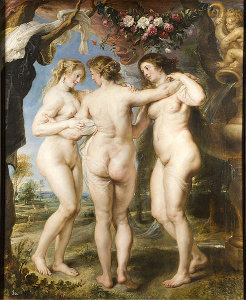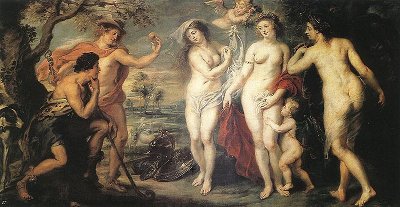I've always struggled with body image and weight issues. Since I was a child, I was plagued by weight loss followed by weight gain until my size settled out into a strange, in between area by the time I started college. I wasn't particularly large, but I certainly wasn't skinny. Whether I was viewed as fat or not really depended on the person looking at me and what their ideal size was. In my late teens and early twenties, if someone asked me to describe my body type to them, I would have had to say something along the lines of “not fat, but not thin, and not really an athlete's frame.” It was a sort of no man's land of self description. I wouldn't have known what else to say. I simply knew of no word to describe my shape. Of course, I could say apple or hourglass or pear, but that didn't quite fit, either.
Several years ago, my husband and I were discussing body shapes. “You're Rubenesque,” he told me firmly. “After the painter. That's what your shape is called.”
The term Rubenesque first got it's start from the Flemish man, Peter Paul Rubens (1577-1640). Rubens was a scholar and peace-loving diplomat that turned the post-Machiavelli, warmongering world on it's ear when he helped Spain and Britain find an uneasy peace with each other in 1630. What he is remembered for most, however, is his art. Rubens mostly painted religious, historical and mythological paintings, along with portraits, and later on he painted some landscapes.

The Three Graces by Rubens
Paintings of full-figured women are some of his most recognizable pieces. Some extra weight on women was considered fashionable at the time and it became Rubens's standard female figure.
Rubenesque was first coined in the middle of the 19th century, but the term didn't become popular until recently. Rubenesque, by standard definition, means a woman that is plump, round, or carries extra weight in a way that is pleasing to look at. However, as beauty is, as they say, in the eye of the beholder, how this word is applied varies from person to person.
To some people, Rubenesque is merely a polite way of saying plus-sized without sounding like an insult. To others, Rubenesque is interchangeable with BBW, or Big Beautiful Women, which in itself is a term used by those that are attracted to overweight or obese women. It was first coined by Carole Shaw when she launched her BBW Magazine in 1979. BBW's come in many sizes, and can be anywhere between carrying just a little bit of extra weight to morbidly obese. By this definition, anyone that carries any extra weight at all can be considered Rubenesque.
Finally, a last group views Rubenesque as carrying a little extra weight, but only carrying it in certain places. This group would consider a woman that is slightly plump but not extremely overweight (medically speaking) and curvy--and those women only--to be Rubenesque. An example of this type of woman would be shapely plus-sized models that seem to have curves in all the right places. Admirers of this body type would be quick to point out that obese women are not Rubenesque, but of course others would argue that they are.

The Judgment of Paris by Rubens
Basically, a Rubenesque woman is someone who is larger than the very thin standard of beauty. How, when, and who the word applies to depends on the speaker and whether or not the woman is comfortable with considering herself to be Rubenesque.
Several years ago, my husband and I were discussing body shapes. “You're Rubenesque,” he told me firmly. “After the painter. That's what your shape is called.”
The term Rubenesque first got it's start from the Flemish man, Peter Paul Rubens (1577-1640). Rubens was a scholar and peace-loving diplomat that turned the post-Machiavelli, warmongering world on it's ear when he helped Spain and Britain find an uneasy peace with each other in 1630. What he is remembered for most, however, is his art. Rubens mostly painted religious, historical and mythological paintings, along with portraits, and later on he painted some landscapes.

The Three Graces by Rubens
Paintings of full-figured women are some of his most recognizable pieces. Some extra weight on women was considered fashionable at the time and it became Rubens's standard female figure.
Rubenesque was first coined in the middle of the 19th century, but the term didn't become popular until recently. Rubenesque, by standard definition, means a woman that is plump, round, or carries extra weight in a way that is pleasing to look at. However, as beauty is, as they say, in the eye of the beholder, how this word is applied varies from person to person.
To some people, Rubenesque is merely a polite way of saying plus-sized without sounding like an insult. To others, Rubenesque is interchangeable with BBW, or Big Beautiful Women, which in itself is a term used by those that are attracted to overweight or obese women. It was first coined by Carole Shaw when she launched her BBW Magazine in 1979. BBW's come in many sizes, and can be anywhere between carrying just a little bit of extra weight to morbidly obese. By this definition, anyone that carries any extra weight at all can be considered Rubenesque.
Finally, a last group views Rubenesque as carrying a little extra weight, but only carrying it in certain places. This group would consider a woman that is slightly plump but not extremely overweight (medically speaking) and curvy--and those women only--to be Rubenesque. An example of this type of woman would be shapely plus-sized models that seem to have curves in all the right places. Admirers of this body type would be quick to point out that obese women are not Rubenesque, but of course others would argue that they are.

The Judgment of Paris by Rubens
Basically, a Rubenesque woman is someone who is larger than the very thin standard of beauty. How, when, and who the word applies to depends on the speaker and whether or not the woman is comfortable with considering herself to be Rubenesque.




Comments